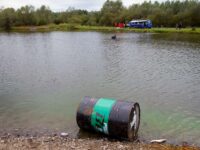War brings environmental concerns. Examples that typically come to mind include Agent Orange, nuclear weapons, deforestation — and now, energy. In February 2022, Russian President Vladimir Putin initiated a military invasion of Ukraine that has since put the European Union in a tailspin of major decisions concerning their future relations with Russia, with energy being one of them. Today, 16 European countries get over 50% of their natural gas from Russia. Finland, Moldova, and Estonia import 100% of their natural gases from Russia. So, it is no fabrication to say that Europe has a not-so-small energy dependence on Russia.
Then, on Sept. 26, 2022, the Nord Stream 2 pipeline, a gas transport line from Russia to Germany that has yet to operate since February’s invasion, suddenly sprung multiple leaks. By Sept. 30, it had released an estimated 115,000 tons of methane gas into our atmosphere. What do climate experts say about the pipeline burst? How can we fix this problem?
By Sept. 30, the Nord Stream 2 pipeline had released an estimated 115,000 tons of methane gas into our atmosphere.
Environmental scientists use carbon dioxide equivalents (CO2e), to give the proportionate effects of greenhouse gases on the environment. For example, 1 kilogram of methane gas has the same effect on the atmosphere as 25 kilograms of carbon dioxide. As of Sept. 30, 2022, the amount of methane that escaped from the pipeline was equivalent to 2.875 million tons of carbon dioxide. The pipeline had not been operating and was simply holding natural gas. Methane greatly affects the temperature and climate of our planet, like all greenhouse gases, and has a lifetime of approximately a decade. Carbon dioxide has a much smaller warming potential but remains in the atmosphere for much longer than methane gas, upwards of 200 years.
The exact amount of methane released by the pipeline has yet to be quantified. No doubt significant, but without an actual number, environmental scientists can only guess the impact of the effusion of methane into our atmosphere. The most reasonable approach to fixing the problem? Light it up. Yes, as wild as it sounds, burning methane gas will create carbon dioxide and water vapor, and the effects of carbon dioxide are much less significant than methane.
The pipeline began construction in the spring of 2021, connecting Europe to energy resources in Russia. The construction raised immediate environmental and safety concerns due to the remnants of World War II violence near the site of the pipeline, most specifically, the chemical munitions dumped in the Baltic Sea by the USSR and the Nazis. With chemical uncertainties in the Baltic Sea, combined with a cautious approach to becoming more reliant on natural gas from Russia, the EU and the general population were hesitant about the construction of the pipeline. Amidst the initial attacks on Ukraine, the construction of the pipeline was stopped. What had been so controversial was nearly forgotten, until the leak in the Baltic Sea was spotted shortly after a sudden pressure drop in the pipeline.
Lund’s team believes that the bust was caused by TNT, as the result of the seismic data changes is similar to previous naval explosions but has no definite evidence that this was the case.
How did it happen? Unsure of what caused the immediate hole in the pipeline, a team of seismologists led by Björn Lund, a professor at Uppsala University in Sweden, used his expertise to look toward the potential causes for a pipeline filled with 90% methane to drop from 105 bar, 103.6 times the atmospheric pressure, to just 7 bar, nearly immediately. Lund’s team believes that the bust was caused by TNT, as the result of the seismic data changes is similar to previous naval explosions but has no definite evidence that this was the case.
Now, as the methane leak slows, two major questions remain. Who, if anyone, is behind the rupture of the Nord Stream 2 pipeline? And what will the European energy dependence on Russia look like in the future?
Image courtesy of Carol M. Highsmith






